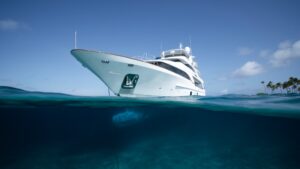Marine fin stabiliser market to reach US$26.1bn by 2033
 Smartgyro / Simrad
Smartgyro / Simrad
A new report finds that the marine fin stabiliser market will grow significantly over the next decade.
A study by market research firm Future Market Insights projects that the marine fin stabiliser market will grow at a compound annual growth rate (CAGR) of 12.1 per cent from 2023 to 2033, reaching a value of around US$26.1bn.
The study predicts that the marine fin stabiliser market will reach US$8.3bn in 2023, up from US$7.2bn in 2022.
Some of this growth is due to the development of zero-speed marine fin stabilisers, which may be used to anchor or prevent ship rocking while at rest.
One of the key elements influencing the market’s demand for marine fin stabilisers is the rising need for cruise ships and yachts for travel and leisure. The shipbuilding industry’s expansion is another significant aspect driving the fin stabiliser market’s demand.
Key drivers
A major factor driving the rising demand for marine fin stabilisers throughout the forecast period is the growing size of the marine fleet. The goal of marine fin stabiliser producers is to offer a variety of fin stabiliser models with minimal water resistance and great efficiency. These are made using cutting-edge materials that have special qualities.
Fin stabiliser demand in the maritime sector is rising due to differentiating factors. Additionally, producers of fin stabilisers are launching completely electric models that are small and light, which is a major contributing element to the rise in demand for these stabilisers among boat owners worldwide.
Modern technology employed by manufacturers allows marine fin stabilisers to function quickly and precisely, as well as to manage boat steering in tandem with the fins. The report finds that these are a few of the main causes of the anticipated rise in the market for marine fin stabilisers.
Factors restraining the market growth
Worldwide confusion among maritime transportation facilities resulted from restricting marine vessels entering other nations for commerce or transit. The epidemic also significantly affected the marine fin stabiliser business by halting commercial, marine, and private leisure operations.
Competitive landscape
The development of innovative fin stabiliser designs for fishing, coast guard, and commerce vessels is the primary emphasis of major participants in the marine fin stabiliser industry. Manufacturers work hard to offer fin stabilisers with cutting-edge technologies that are also dependable and long-lasting. In addition, many businesses concentrate on expanding their global geographic reach by forming alliances and working together with other firms.
The report highlights several examples, including:
- In Oct 2021, Kongsberg Maritime announced a contract with Finnish shipyard Rauma Marine Constructions (RMC) to deliver marine propulsion and steering equipment for passenger ferries.
- In April 2020, Quantum Marine Stabilizers announced their first contract for the latest innovation Dyna Foil, which is a retractable system for high-speed fin stabilisation.
- In Sept 2020, SKF Group designed electrically powered, non-retractable fin stabilisers for luxury yachts, thus adding a new category of fin stabilisers to its marine equipment range.
Earlier this month, MIN reported that stabiliser, thruster, steering and intruder system developer CMC Marine had partnered with Gyro Marine, an Italian marine gyroscope technology specialist.
Under the new agreement, Gyro Marine gyroscopes will be integrated into the range of products CMC Marine offers to its customers worldwide, in both the yachting industry and beyond.
Another Italian stabiliser company, Smartgyro, also exhibited its range of gyro stabilisers at boot Düsseldorf 2023, including the new SG150 model – its biggest to date.
Main image, courtesy of Smartgyro/Simrad.










